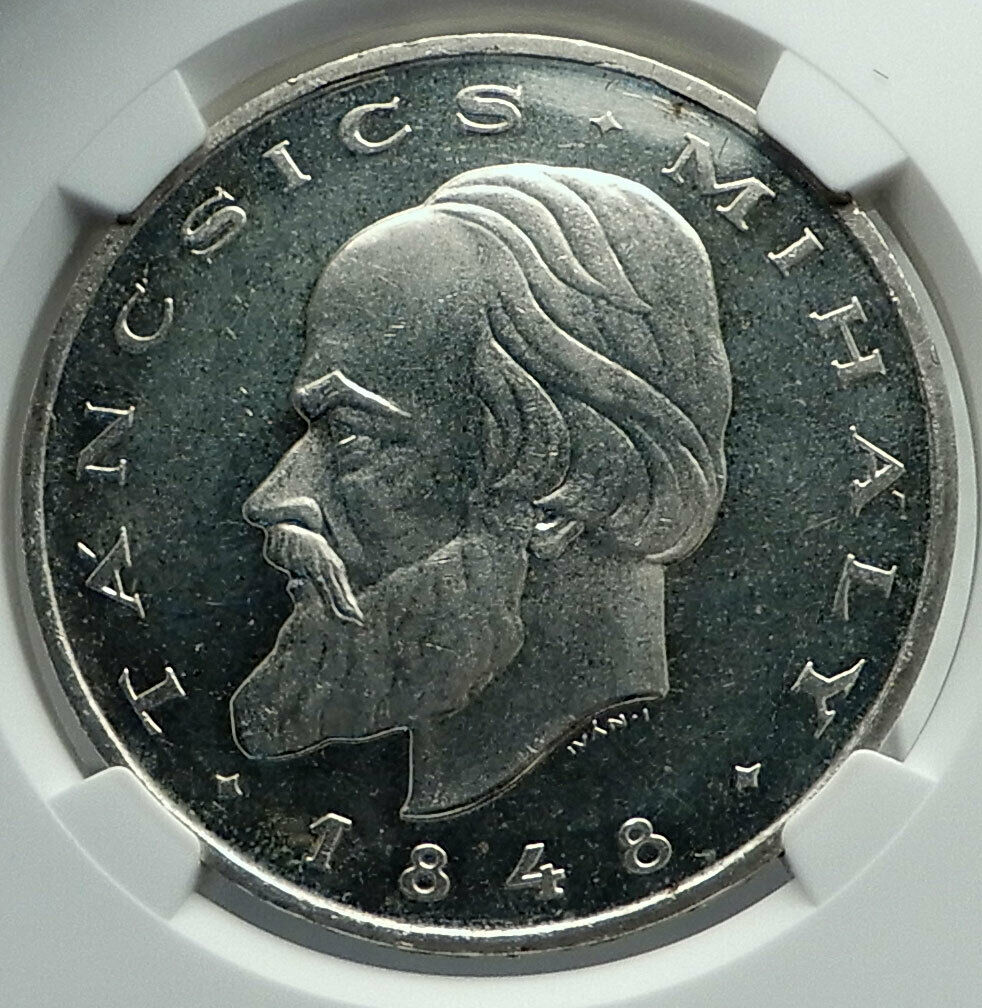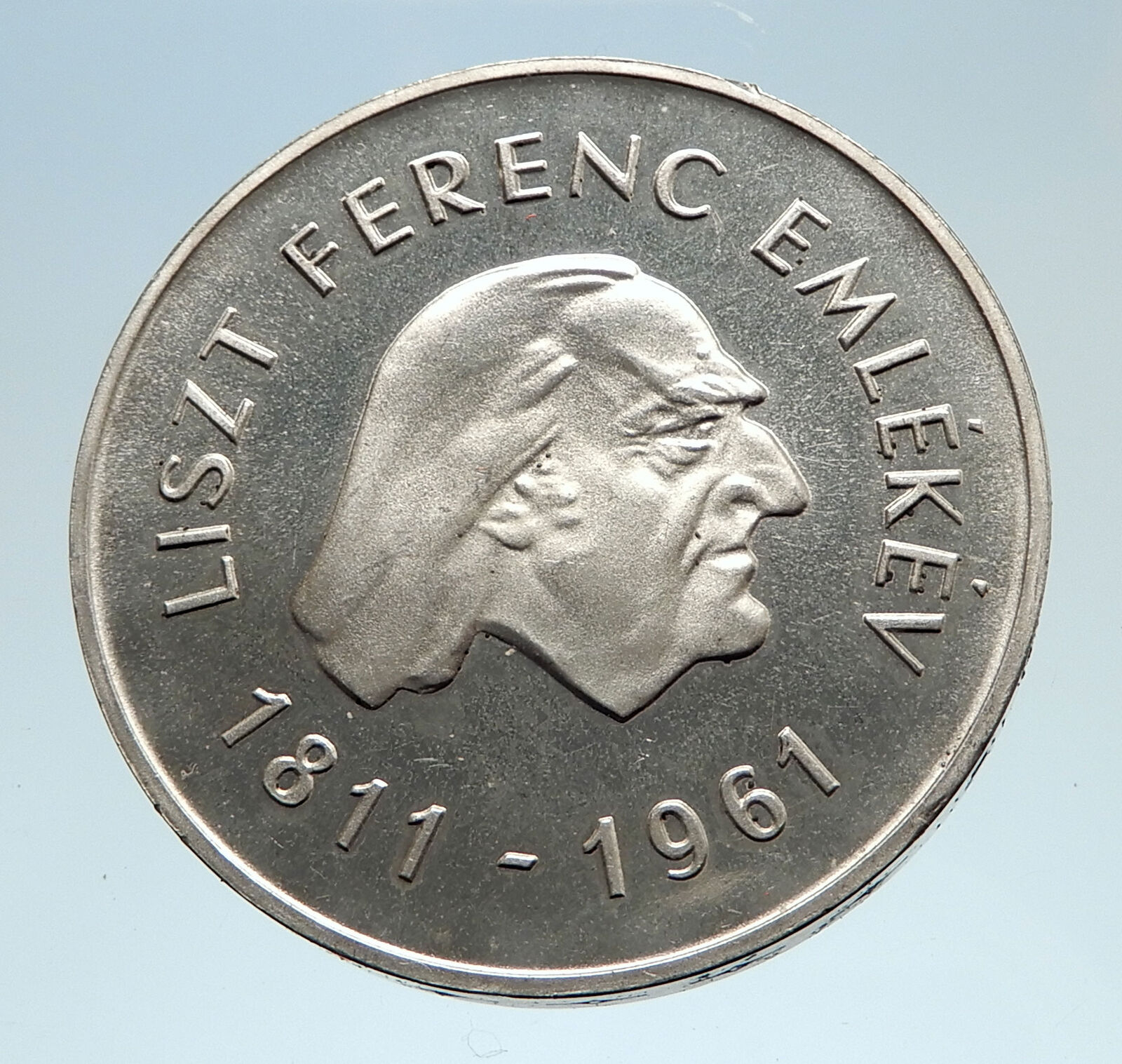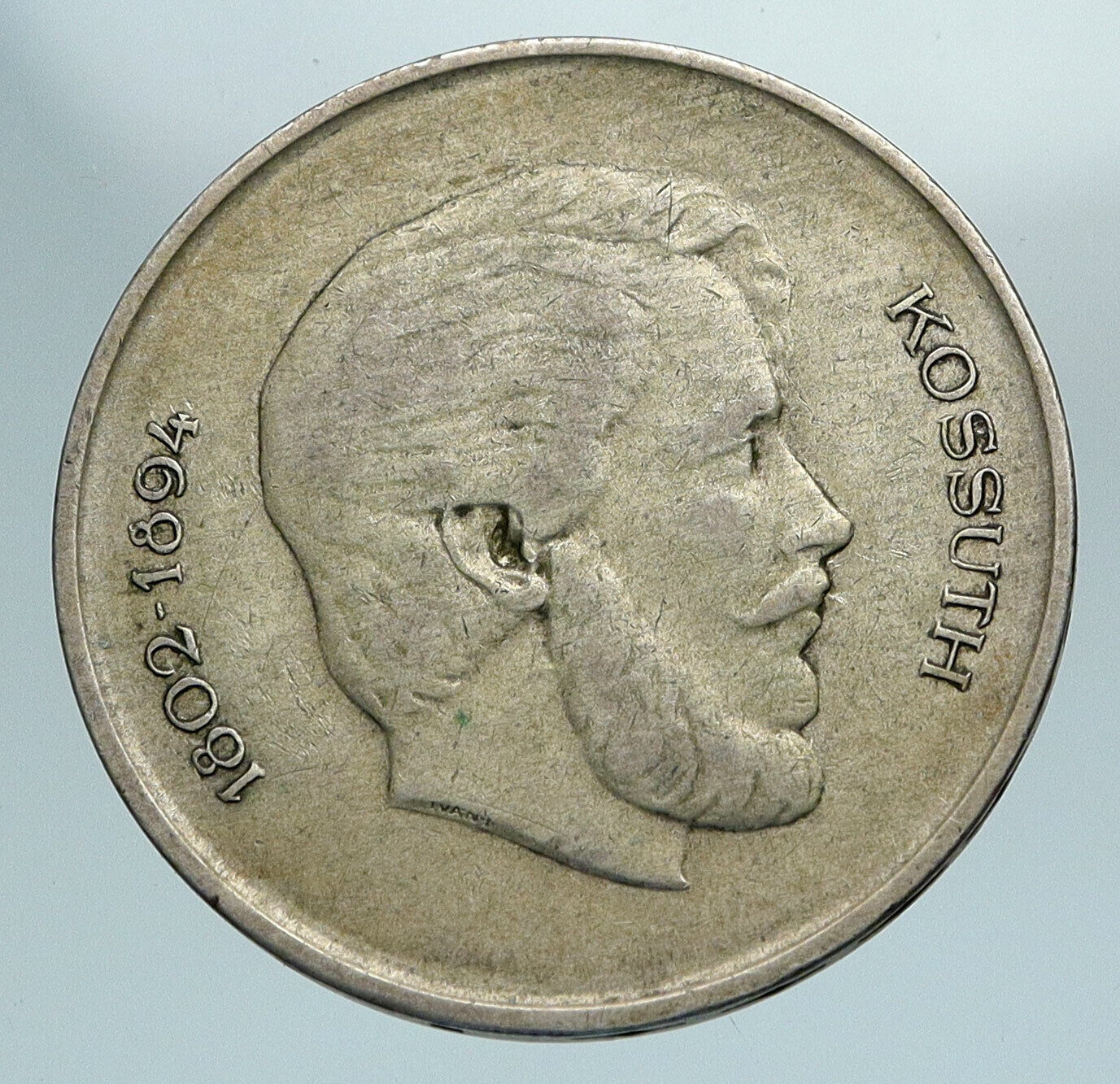|
Hungary
80th Anniversary of Birth of Béla Bartók
1961 Proof Silver 50 Forint 33mm (19.80 grams) 0.750 Silver (0.4823 oz. ASW)
Reference: KM# 561 | István Ivan
Certification: NGC
PF 67 CAMEO 2863704-013
MAGYAR NÉPKÖZTÁRSASÁG 50 FORINT 1961 BP, Lyre.
BARTÓK BÉLA EMLÉKÉV 1881-1961, Bartok facing right.
Edge Lettering:
M. Á. P. V.
You are bidding on the exact item pictured, provided with a Certificate of Authenticity and Lifetime Guarantee of Authenticity.
 Béla Viktor János Bartók (/ˈbeɪlə ˈbɑːrtɒk/; Hungarian: Bartók Béla, pronounced [ˈbɒrtoːk ˈbeːlɒ]; 25 March 1881 – 26 September 1945) was a Hungarian composer, pianist, and ethnomusicologist. He is considered one of the most important composers of the 20th century; he and Franz Liszt are regarded as Hungary’s greatest composers (Gillies 2001). Through his collection and analytical study of folk music, he was one of the founders of comparative musicology, which later became ethnomusicology. Béla Viktor János Bartók (/ˈbeɪlə ˈbɑːrtɒk/; Hungarian: Bartók Béla, pronounced [ˈbɒrtoːk ˈbeːlɒ]; 25 March 1881 – 26 September 1945) was a Hungarian composer, pianist, and ethnomusicologist. He is considered one of the most important composers of the 20th century; he and Franz Liszt are regarded as Hungary’s greatest composers (Gillies 2001). Through his collection and analytical study of folk music, he was one of the founders of comparative musicology, which later became ethnomusicology.
Bartók was born in the Banatian town of Nagyszentmiklós in the Kingdom of Hungary (present-day Sânnicolau Mare, Romania) on 25 March 1881.
Bartók had a diverse ancestry. On his father’s side, the Bartók family was a Hungarian lower noble family, originating from Borsodszirák, Borsod (Móser 2006a, 44). His paternal grandmother was a Catholic of Bunjevci origin, but considered herself Hungarian (Szekernyés 2017). Bartók’s father was also named Béla; although his mother, Paula (née Voit), had ethnic German roots, she spoke Hungarian fluently (Hooker 2001, 16). She was a native of Turócszentmárton (present-day Martin, Slovakia) (Cooper 2015, 6). Paula also had Hungarian (Teréz Fegyveres) and Slavic (Polereczky: Magyarized Slavic (Anon. & n.d.(c))) ancestors.[citation needed]
Béla displayed notable musical talent very early in life: according to his mother, he could distinguish between different dance rhythms that she played on the piano before he learned to speak in complete sentences (Gillies 1990, 6). By the age of four he was able to play 40 pieces on the piano and his mother began formally teaching him the next year.
Béla was a sickly child and suffered from severe eczema until the age of five (Gillies 1990, 5), as a result of an inoculation with a faulty smallpox vaccine, with his facial disfigurement causing him to avoid people (Suchoff 2001, 15). In 1888, when he was seven, his father, the director of an agricultural school, died suddenly. His mother then took Béla and his sister, Erzsébet, to live in Nagyszőlős (present-day Vynohradiv, Ukraine) and then in Pozsony (present-day Bratislava, Slovakia).
He gave his first public recital aged 11 in Nagyszőlős, to a warm critical reception (Griffiths 1988). Among the pieces he played was his own first composition, written two years previously: a short piece called “The Course of the Danube” (de Toth 1999). Shortly thereafter László Erkel accepted him as a pupil (Stevens 1964, 8).
Opera
In 1911, Bartók wrote what was to be his only opera, Bluebeard’s Castle, dedicated to Márta. He entered it for a prize by the Hungarian Fine Arts Commission, but they rejected his work as not fit for the stage (Chalmers 1995, 93). In 1917 Bartók revised the score for the 1918 première, and rewrote the ending. Following the 1919 revolution in which he actively participated, he was pressured by the Horthy regime to remove the name of the librettist Béla Balázs from the opera (Chalmers 1995, 123), as Balázs was of Jewish origin, was blacklisted, and had left the country for Vienna. Bluebeard’s Castle received only one revival, in 1936, before Bartók emigrated. For the remainder of his life, although he was passionately devoted to Hungary, its people and its culture, he never felt much loyalty to the government or its official establishments.
World War II and last years in America (1940-45)
In 1940, as the European political situation worsened after the outbreak of World War II, Bartók was increasingly tempted to flee Hungary. He strongly opposed the Nazis and Hungary’s alliance with Germany and the Axis powers under the Tripartite Pact. After the Nazis came to power in the early 1930s, Bartók refused to give concerts in Germany and broke away from his publisher there. His anti-fascist political views caused him a great deal of trouble with the establishment in Hungary. Having first sent his manuscripts out of the country, Bartók reluctantly emigrated to the U.S. with his wife Ditta in October that year. They settled in New York City after arriving on the night of 29-30 October 1940 via a steamer from Lisbon. After joining them in 1942, their younger son, Péter Bartók, enlisted in the United States Navy where he served in the Pacific during the remainder of the war and later settled in Florida where he became a recording and sound engineer. His elder son, by his first marriage, Béla Bartók III, remained in Hungary and later worked as a railroad official until his retirement in the early 1980s.
Although he became an American citizen in 1945, shortly before his death (Gagné 2012, 28), Bartók never felt fully at home in the USA. He initially found it difficult to compose. Although he was well known in America as a pianist, ethnomusicologist and teacher, he was not well known as a composer. There was little American interest in his music during his final years. He and his wife Ditta gave some concerts, although demand for them was low.[citation needed] Bartók, who had made some recordings in Hungary, also recorded for Columbia Records after he came to the US; many of these recordings (some with Bartók’s own spoken introductions) were later issued on LP and CD (Bartók 1994, 1995a, 1995b, 2003, 2007, 2008).
Supported by a research fellowship from Columbia University, for several years, Bartók and Ditta worked on a large collection of Serbian and Croatian folk songs in Columbia’s libraries. Bartók’s economic difficulties during his first years in America were mitigated by publication royalties, teaching and performance tours. While his finances were always precarious, he did not live and die in poverty as was the common myth. He had enough friends and supporters to ensure that there was sufficient money and work available for him to live on. Bartók was a proud man and did not easily accept charity. Despite being short on cash at times, he often refused money that his friends offered him out of their own pockets. Although he was not a member of the ASCAP, the society paid for any medical care he needed during his last two years. Bartók reluctantly accepted this (Chalmers 1995, 196-203).
The first symptoms of his health problems began late in 1940, when his right shoulder began to show signs of stiffening. In 1942, symptoms increased and he started having bouts of fever, but no underlying disease was diagnosed, in spite of medical examinations. Finally, in April 1944, leukemia was diagnosed, but by this time, little could be done (Chalmers 1995, 202-07).
As his body slowly failed, Bartók found more creative energy, and he produced a final set of masterpieces, partly thanks to the violinist Joseph Szigeti and the conductor Fritz Reiner (Reiner had been Bartók’s friend and champion since his days as Bartók’s student at the Royal Academy). Bartók’s last work might well have been the String Quartet No. 6 but for Serge Koussevitzky’s commission for the Concerto for Orchestra. Koussevitsky’s Boston Symphony Orchestra premièred the work in December 1944 to highly positive reviews. The Concerto for Orchestra quickly became Bartók’s most popular work, although he did not live to see its full impact. In 1944, he was also commissioned by Yehudi Menuhin to write a Sonata for Solo Violin. In 1945, Bartók composed his Piano Concerto No. 3, a graceful and almost neo-classical work, as a surprise 42nd birthday present for Ditta, but he died just over a month before her birthday, with the scoring not quite finished. He had also sketched his Viola Concerto, but had barely started the scoring at his death, leaving completed only the viola part and sketches of the orchestral part.
Béla Bartók died at age 64 in a hospital in New York City from complications of leukemia (specifically, of secondary polycythemia) on 26 September 1945. His funeral was attended by only ten people. Among them were his wife Ditta, their son Péter, and his pianist friend György Sándor (Anon. 2006).
Bartók’s body was initially interred in Ferncliff Cemetery in Hartsdale, New York. During the final year of communist Hungary in the late 1980s, the Hungarian government, along with his two sons, Béla III and Péter, requested that his remains be exhumed and transferred back to Budapest for burial, where Hungary arranged a state funeral for him on 7 July 1988. He was reinterred at Budapest’s Farkasréti Cemetery, next to the remains of Ditta, who died in 1982, the year after his centenary (Chalmers 1995, 214).
The two unfinished works were later completed by his pupil Tibor Serly. György Sándor was the soloist in the first performance of the Third Piano Concerto on February 8, 1946. Ditta Pásztory-Bartók later played and recorded it. The Viola Concerto was revised and published in the 1990s by Bartók’s son, Peter (Maurice 2004); this version may be closer to what Bartók intended (Chalmers 1995, 210).
Concurrently, Peter Bartók, in association with Argentinian musician Nelson Dellamaggiore, worked to reprint and revise past editions of the Third Piano Concerto (Somfai 1996).

 Hungary is a sovereign state in Europe. It is situated in the Carpathian Basin and is bordered by Slovakia to the north, Romania to the east, Serbia to the south, Croatia to the southwest, Slovenia to the west, Austria to the northwest, and Ukraine to the northeast. The country’s capital and largest city is Budapest. Hungary is a member of the European Union, NATO, the OECD, the Visegrád Group, and the Schengen Area. The official language is Hungarian, which is the most widely spoken non-Indo-European language in Europe. Hungary is a sovereign state in Europe. It is situated in the Carpathian Basin and is bordered by Slovakia to the north, Romania to the east, Serbia to the south, Croatia to the southwest, Slovenia to the west, Austria to the northwest, and Ukraine to the northeast. The country’s capital and largest city is Budapest. Hungary is a member of the European Union, NATO, the OECD, the Visegrád Group, and the Schengen Area. The official language is Hungarian, which is the most widely spoken non-Indo-European language in Europe.
 Following centuries of successive habitation by Celts, Romans, Huns, Slavs, Gepids, and Avars, the foundation of Hungary was laid in the late 9th century by the Hungarian grand prince Árpád in the Honfoglalás (“homeland-conquest”). His great-grandson Stephen I ascended to the throne in 1000 CE, converting the country to a Christian kingdom. By the 12th century, Hungary became a middle power within the Western world, reaching a golden age by the 15th century. Following the Battle of Mohács in 1526 and about 150 years of partial Ottoman occupation (1541-1699), Hungary came under Habsburg rule, and later formed a significant part of the Austro-Hungarian Empire (1867-1918). Following centuries of successive habitation by Celts, Romans, Huns, Slavs, Gepids, and Avars, the foundation of Hungary was laid in the late 9th century by the Hungarian grand prince Árpád in the Honfoglalás (“homeland-conquest”). His great-grandson Stephen I ascended to the throne in 1000 CE, converting the country to a Christian kingdom. By the 12th century, Hungary became a middle power within the Western world, reaching a golden age by the 15th century. Following the Battle of Mohács in 1526 and about 150 years of partial Ottoman occupation (1541-1699), Hungary came under Habsburg rule, and later formed a significant part of the Austro-Hungarian Empire (1867-1918).
Hungary’s current borders were first established by the Treaty of Trianon (1920) after World War I, when the country lost 71% of its territory, 58% of its population, and 32% of ethnic Hungarians. Following the interwar period, Hungary joined the Axis Powers in World War II, suffering significant damage and casualties. Hungary came under the influence of the Soviet Union, which contributed to the establishment of a four-decade-long communist dictatorship (1947-1989). The country gained widespread international attention regarding the Revolution of 1956 and the seminal opening of its previously-restricted border with Austria in 1989, which accelerated the collapse of the Eastern Bloc.
On 23 October 1989, Hungary again became a democratic parliamentary republic, and today has a high-income economy with a very high Human Development Index. Hungary is a popular tourist destination attracting 10.675 million tourists a year (2013). It is home to the largest thermal water cave system and the second-largest thermal lake in the world (Lake Hévíz), the largest lake in Central Europe (Lake Balaton), and the largest natural grasslands in Europe (the Hortobágy National Park).
|








 Béla Viktor János Bartók (/ˈbeɪlə ˈbɑːrtɒk/; Hungarian: Bartók Béla, pronounced [ˈbɒrtoːk ˈbeːlɒ]; 25 March 1881 – 26 September 1945) was a Hungarian composer, pianist, and ethnomusicologist. He is considered one of the most important composers of the 20th century; he and Franz Liszt are regarded as Hungary’s greatest composers (Gillies 2001). Through his collection and analytical study of folk music, he was one of the founders of comparative musicology, which later became ethnomusicology.
Béla Viktor János Bartók (/ˈbeɪlə ˈbɑːrtɒk/; Hungarian: Bartók Béla, pronounced [ˈbɒrtoːk ˈbeːlɒ]; 25 March 1881 – 26 September 1945) was a Hungarian composer, pianist, and ethnomusicologist. He is considered one of the most important composers of the 20th century; he and Franz Liszt are regarded as Hungary’s greatest composers (Gillies 2001). Through his collection and analytical study of folk music, he was one of the founders of comparative musicology, which later became ethnomusicology. 
 Hungary is a sovereign state in Europe. It is situated in the Carpathian Basin and is bordered by Slovakia to the north, Romania to the east, Serbia to the south, Croatia to the southwest, Slovenia to the west, Austria to the northwest, and Ukraine to the northeast. The country’s capital and largest city is Budapest. Hungary is a member of the European Union, NATO, the OECD, the Visegrád Group, and the Schengen Area. The official language is Hungarian, which is the most widely spoken non-Indo-European language in Europe.
Hungary is a sovereign state in Europe. It is situated in the Carpathian Basin and is bordered by Slovakia to the north, Romania to the east, Serbia to the south, Croatia to the southwest, Slovenia to the west, Austria to the northwest, and Ukraine to the northeast. The country’s capital and largest city is Budapest. Hungary is a member of the European Union, NATO, the OECD, the Visegrád Group, and the Schengen Area. The official language is Hungarian, which is the most widely spoken non-Indo-European language in Europe. Following centuries of successive habitation by Celts, Romans, Huns, Slavs, Gepids, and Avars, the foundation of Hungary was laid in the late 9th century by the Hungarian grand prince Árpád in the Honfoglalás (“homeland-conquest”). His great-grandson Stephen I ascended to the throne in 1000 CE, converting the country to a Christian kingdom. By the 12th century, Hungary became a middle power within the Western world, reaching a golden age by the 15th century. Following the Battle of Mohács in 1526 and about 150 years of partial Ottoman occupation (1541-1699), Hungary came under Habsburg rule, and later formed a significant part of the Austro-Hungarian Empire (1867-1918).
Following centuries of successive habitation by Celts, Romans, Huns, Slavs, Gepids, and Avars, the foundation of Hungary was laid in the late 9th century by the Hungarian grand prince Árpád in the Honfoglalás (“homeland-conquest”). His great-grandson Stephen I ascended to the throne in 1000 CE, converting the country to a Christian kingdom. By the 12th century, Hungary became a middle power within the Western world, reaching a golden age by the 15th century. Following the Battle of Mohács in 1526 and about 150 years of partial Ottoman occupation (1541-1699), Hungary came under Habsburg rule, and later formed a significant part of the Austro-Hungarian Empire (1867-1918).




